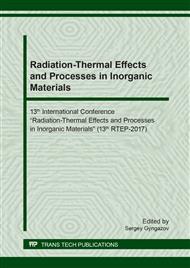p.82
p.88
p.95
p.101
p.108
p.114
p.119
p.125
p.131
Criterion for Controlling the Stress-Strain State of Composite Dielectric Materials Using the Effective Filtration Method
Abstract:
The paper presents a brief description of a process of an electromagnetic response generation from dielectric composite materials when they are subjected to an acoustic impulses, a recording method by capacitive receivers and criteria for controlling the stress-strain state (SSS) for this method. Also there are the results of studies of the applicability of the effective filtration method for the control of similar products from epoxy resin with sand filler. The formation of a response with a pronounced maximum and an excitation pulse symmetric with respect to the end time is determined when a coherent signal is input to the input of the system, which is a mirror image of the impulse response. The correlation coefficient between the left and right parts of the response was chosen as a criterion for controlling the SSS.
Info:
Periodical:
Pages:
108-113
Citation:
Online since:
September 2018
Authors:
Price:
Сopyright:
© 2018 Trans Tech Publications Ltd. All Rights Reserved
Share:
Citation:


